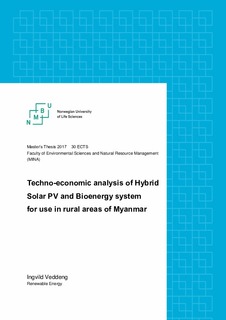| dc.contributor.advisor | Adaramola, Myuiwa Samuel | |
| dc.contributor.author | Veddeng, Ingvild | |
| dc.coverage.spatial | Myanmar | nb_NO |
| dc.date.accessioned | 2018-09-27T11:23:14Z | |
| dc.date.available | 2018-09-27T11:23:14Z | |
| dc.date.issued | 2017 | |
| dc.identifier.uri | http://hdl.handle.net/11250/2564977 | |
| dc.description.abstract | Myanmar is situated in the southern part of Asia. This is a country with a high need of increasing their electrification ratio. As much as 70 % of the population are living in rural areas, where the national grid only reaches 7 % of the villagers. Despite limited financing and geographical challenges in rural areas, hybrid renewable energy systems (HRES) may safely generate electricity to rural areas with low energy requirements, and without the need of implementing large facilities or network. An advantage of utilising HRES is the possibility to employ two or more complementary locally available sources of energy.
The objective of this thesis was to find the optimal design and performance of a Hybrid Renewable Energy System (HRES) consisting of Solar PV and bioenergy, which will both meet the energy demand and benefit the local people in Amatgyi Khone, a selected rural village of Myanmar. A field survey research was conducted in the Amatgyi Khone, where quantitative method was used to estimate the village’s future load requirements. There are 256 households, schools and public utilities, which altogether, require a daily average primary load of 44,7 kW and a peak load of 107 kW. The region of Amatgyi Khone has abundant availability of solar energy (5,38 kWh/m2/day) and agricultural crop residues, especially rice husks (2,96 tonnes/day). The selected HRES components comprise Solar PV system, Bio Gasifier Power Plant (BGPP) and battery bank. Several system configurations have been simulated using HOMER software. The total net present cost (NPC) of each system configuration has been calculated for a system lifetime of 25 years, in order to find the lowest energy cost configuration.
The optimal HRES components have the following capacities: Solar PV - 150 kW, bio-gen #1 - 75 kW, bio-gen #2 - 50 kW, inverter - 120 kW and battery bank - 23.966 kWh. The HRES can supply 100 % renewable power with no capacity shortage to the end-users, through mini-grid distribution LV lines. The BGPP accounts for 53,64 % of the total annual generated primary load, and 37 % is generated by the Solar PV system. The estimated value of the NPC and Levelized Cost of Energy (LCOE) is $2.938.238 and $0,719/kWh, respectively. However, by introducing different types of governmental or donor support, the LCOE can be reduced in various amounts. The LCOE can be reduced to $0,266/kWh when the BGPP Operation & maintenance (O&M) costs are completely subsidised. Governmental or donor support is regarded essential for making the electricity supply affordable to the end-users and to ensure development of the energy system. | nb_NO |
| dc.description.abstract | Myanmar er ett land som er lokalisert i den sørlige delen av Asia. Behovet for å øke elektrifiseringsforholdet i Myanmar er stort. Hele 70% av befolkningen bor i landlige områder, hvor det nasjonale nettverket bare når 7% av landsbyboerne. Til tross for begrenset finansiering og geografiske utfordringer i rurale områder, kan hybridfornybare energisystemer (HFES) stabilt generere elektrisitet til ruralområder med lave energibehov, og uten behov for å implementere store anlegg eller nettverk. En fordel ved å benytte HFES er muligheten til å kunne benytte to eller flere komplementerende, lokalt tilgjengelige energikilder. Målet med denne oppgaven var å finne det optimale design og ytelse til et hybrid fornybart energisystem (HFES) som består av PV-system og bioenergi. Det HFES skal både møte energibehovet og nytte lokalbefolkningen i Amatgyi Khone, en utvalgt rural landsby Myanmar. En feltundersøkelse ble utført i Amatgyi Khone, hvor kvantitativ metode ble brukt til å estimere landsbyens fremtidige effektbehov. Det er 256 husholdninger, skoler og offentlige forsyninger, som totalt, krever en daglig gjennomsnittlig primær effekt på 44,7 kW og en topp-effekt på 107 kW. Amatgyi Khone-regionen har rikelig med solinnstråling (5,38 kWh / m2 / dag) og jordbruksavlinger, spesielt risskall (2,96 tonn / dag). De utvalgte HFES-komponentene omfatter solcellepanel, biogassifiseringskraftverk (BGPP) og batteribank. BGPP består av en «downdraft» forgasser, kombinert med to biogass-generatorer. Flere systemkonfigurasjoner har blitt simulert ved hjelp av programvaren HOMER. Den totale netto-nåverdi (NPC) for hver systemkonfigurasjon er beregnet for en systemlivstid på 25 år for å finne den billigste system-konfigurasjonen. De optimale HRES-komponentene har følgende kapasiteter: Sol PV - 150 kW, bio-gen. # 1 - 75 kW, bio-gen. # 2 - 50 kW, inverter - 120 kW og batteribank - 23.966 kWh. Det HFES kan levere 100% fornybar kraft uten kapasitetsmangel til sluttbrukerne, via mini-nettverks distribusjon LV linjer. BGPP står for 53,64% av den totale årlige genererte primærbelastningen, og 37% genereres av Solar PV-systemet. Den estimerte verdien av NPC og LCOE er henholdsvis $ 2 938 248 og $ 0,719 / kWh. Imidlertid kan LCOE reduseres i ulike mengder ved å introdusere ulike typer statlig- eller donorstøtte. LCOE kan reduseres til $ 0,266 / kWh når BGPP O & M kostnadene er fullstendig subsidiert. Statlig støtte eller donorstøtte anses å være avgjørende for å gjøre elforsyningen rimelig for sluttbrukere og for å sikre utvikling av energisystemet. | nb_NO |
| dc.language.iso | eng | nb_NO |
| dc.publisher | Norwegian University of Life Sciences, Ås | nb_NO |
| dc.rights | Attribution-NonCommercial-NoDerivatives 4.0 Internasjonal | * |
| dc.rights.uri | http://creativecommons.org/licenses/by-nc-nd/4.0/deed.no | * |
| dc.subject | HOMER | nb_NO |
| dc.subject | Rice husk | nb_NO |
| dc.subject | Solar PV | nb_NO |
| dc.subject | Renewable energy | nb_NO |
| dc.subject | Energy systems | nb_NO |
| dc.title | Techno-economic analysis of Hybrid Solar PV and Bioenergy system for use in rural areas of Myanmar | nb_NO |
| dc.type | Master thesis | nb_NO |
| dc.source.pagenumber | 117 | nb_NO |
| dc.description.localcode | M-FORNY | nb_NO |

